Abstract
Asthma is a clinical condition characterized by intermittent respiratory symptoms, nonspecific airway hyperresponsiveness, and reversible airway obstruction. Although the pathogenesis of asthma is incompletely understood, it is clear that airway inflammation is a paramount feature of the condition. Because inhalation of ozone by normal, healthy subjects causes increased airway responsiveness and inflammation, it is somewhat surprising that most controlled human exposure studies that have involved asthmatic subjects have not shown them to be especially sensitive to ozone. The acute decrement in lung function that is the end point traditionally used to define sensitivity to ozone in these studies may be due more to neuromuscular mechanisms limiting deep inspiration than to bronchoconstriction. The frequency of asthma attacks following ozone exposures may be a more relevant end point. Epidemiologic studies, rather than controlled human exposure studies, are required to determine whether ozone pollution increases the risk of asthma exacerbations. Asthma affects approximately 10 million people in the United States and, thus, the answer to this question is of considerable public health importance. Both the prevalence and severity of asthma appear to be increasing in many countries. Although increased asthma morbidity and mortality are probably of multifactorial etiology, a contributory role of urban air pollution is plausible. The epidemiologic database to support an association between asthma and ozone exposure is limited, but the results of several studies suggest such an association. Some potential approaches to further investigation of the relationship between asthma and ozone, including those that would link controlled human exposures to population-based studies, are considered.
Full text
PDF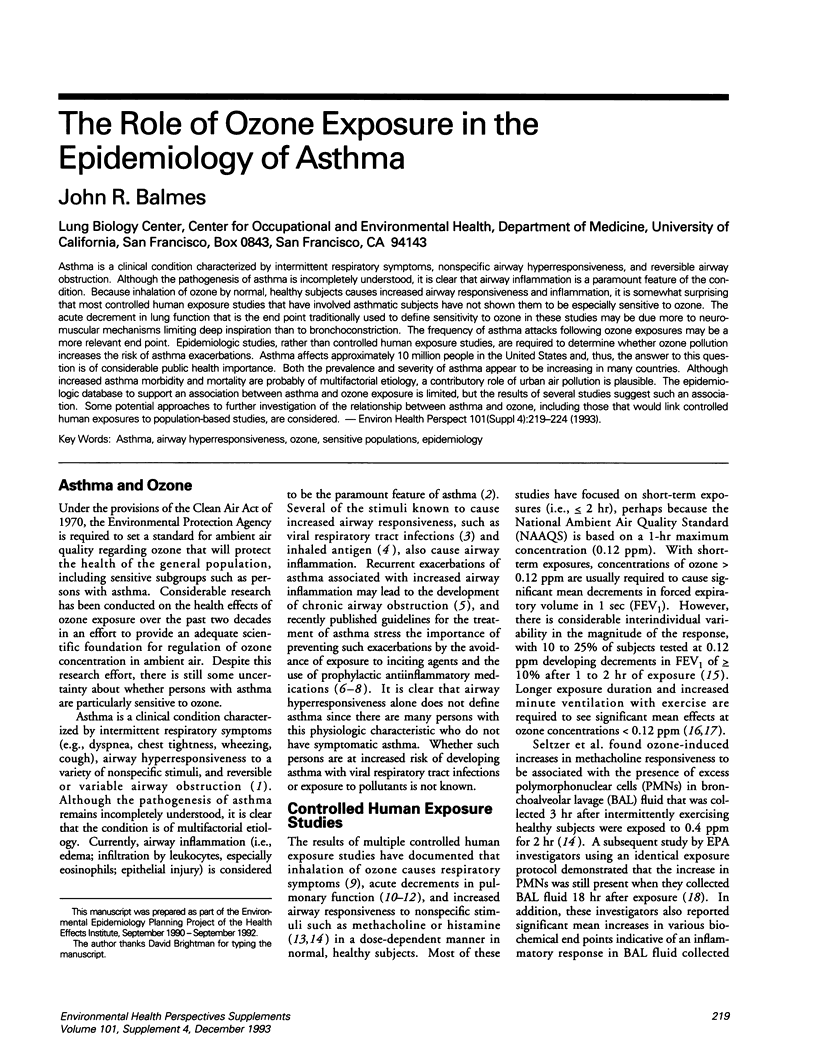
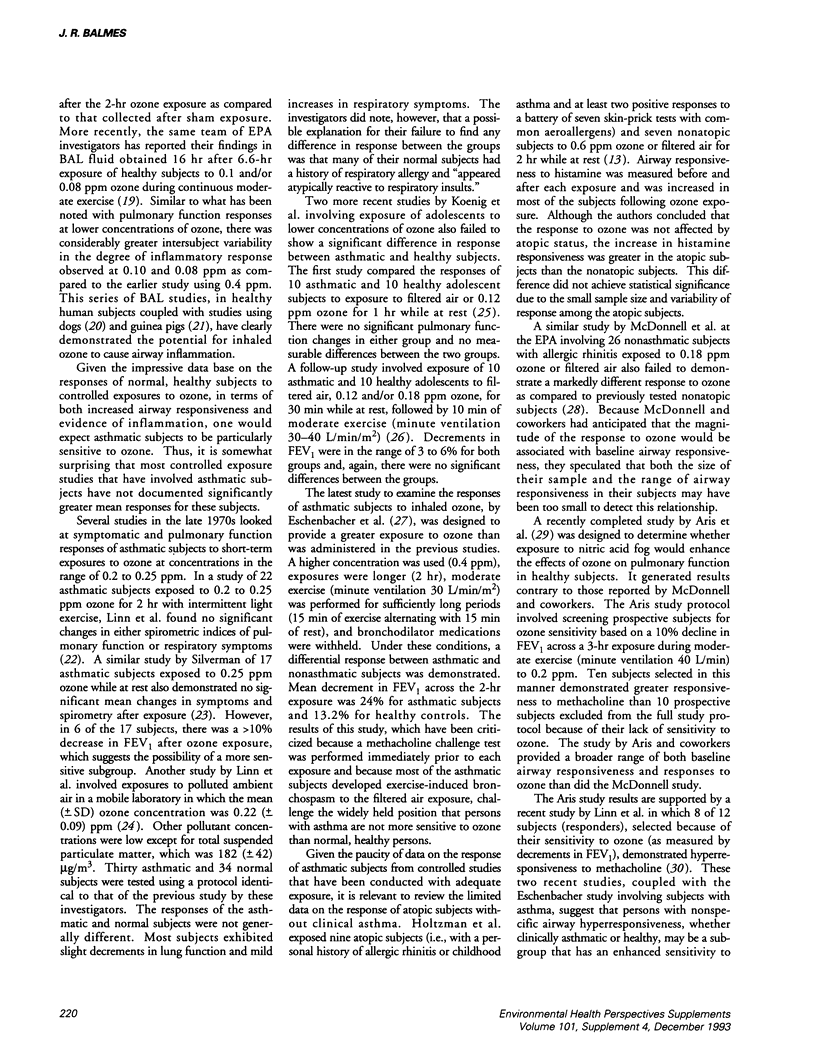
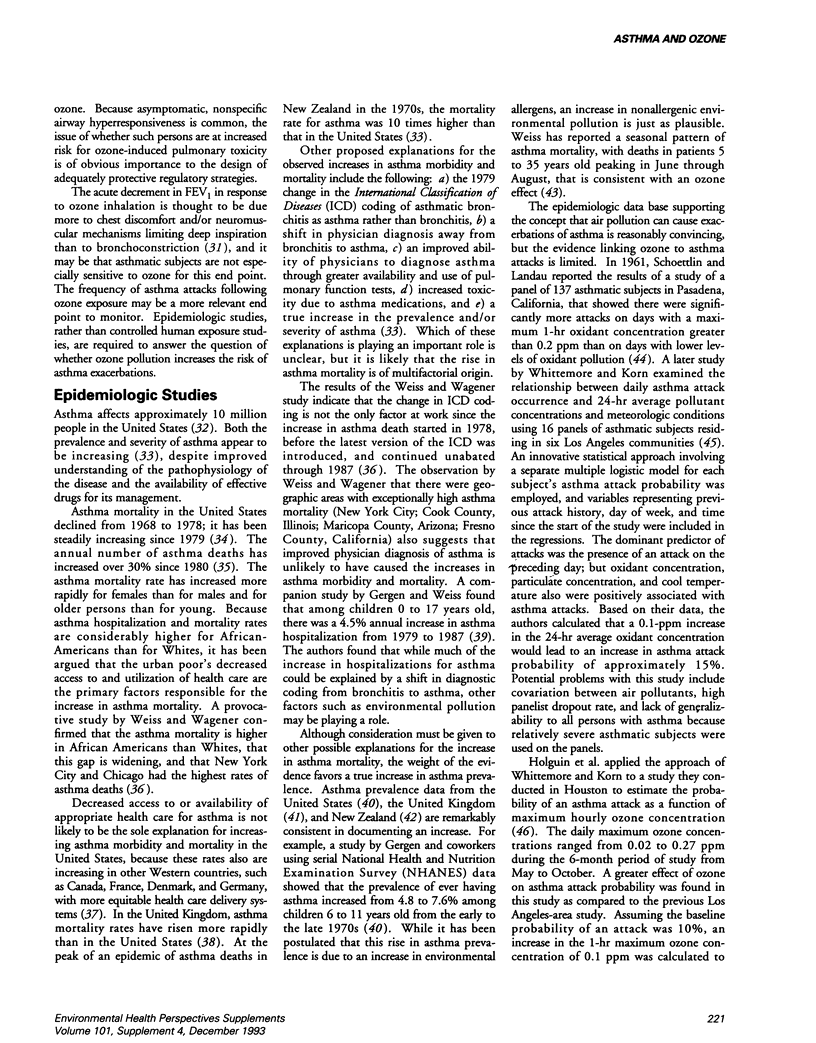
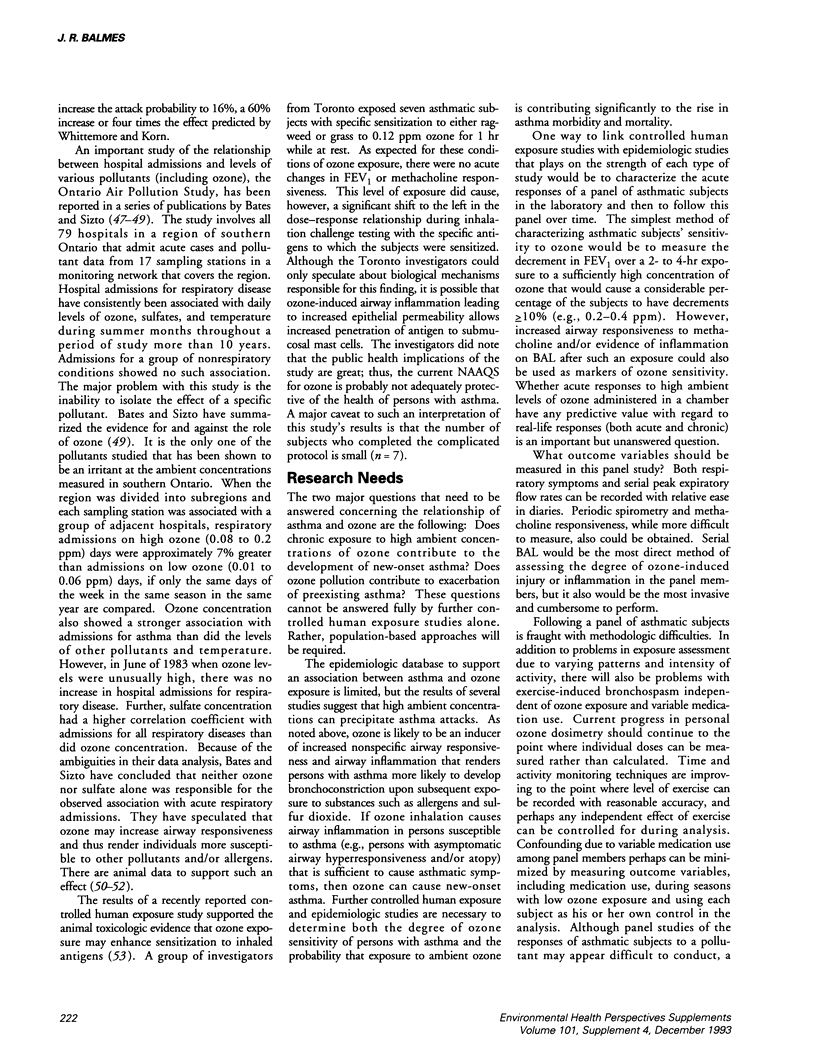
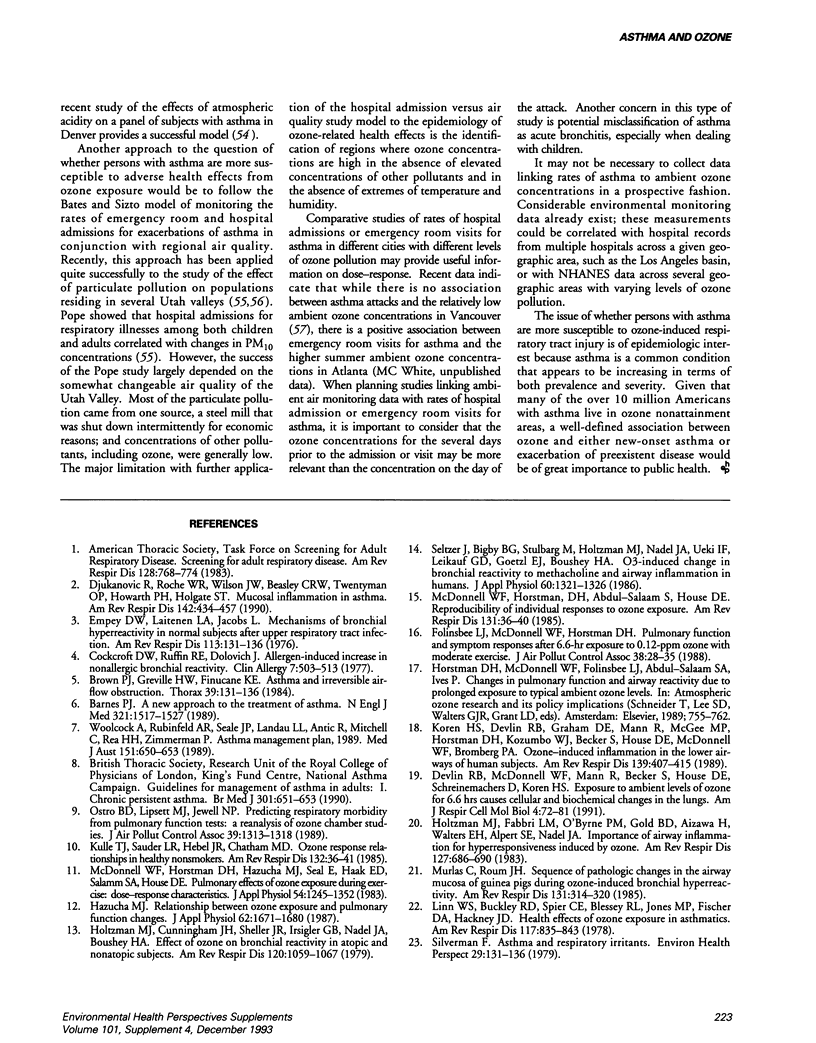
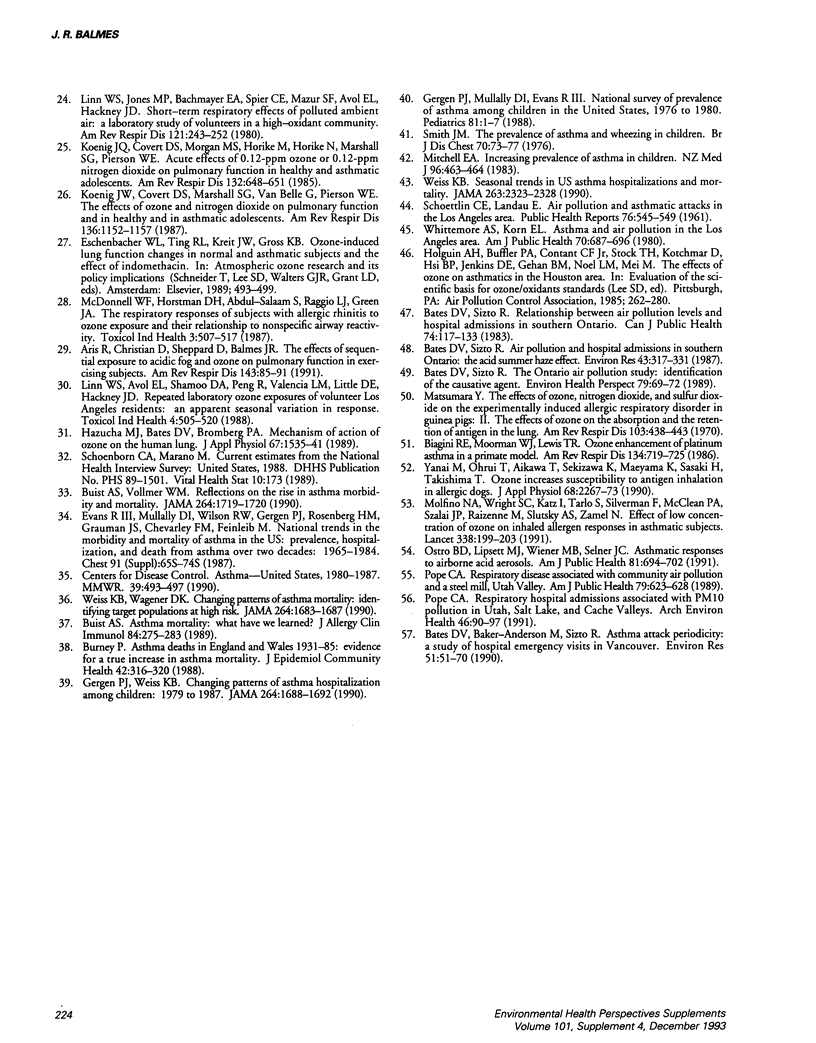
Selected References
These references are in PubMed. This may not be the complete list of references from this article.
- Aris R., Christian D., Sheppard D., Balmes J. R. The effects of sequential exposure to acidic fog and ozone on pulmonary function in exercising subjects. Am Rev Respir Dis. 1991 Jan;143(1):85–91. doi: 10.1164/ajrccm/143.1.85. [DOI] [PubMed] [Google Scholar]
- Barnes P. J. A new approach to the treatment of asthma. N Engl J Med. 1989 Nov 30;321(22):1517–1527. doi: 10.1056/NEJM198911303212206. [DOI] [PubMed] [Google Scholar]
- Bates D. V., Baker-Anderson M., Sizto R. Asthma attack periodicity: a study of hospital emergency visits in Vancouver. Environ Res. 1990 Feb;51(1):51–70. doi: 10.1016/s0013-9351(05)80182-3. [DOI] [PubMed] [Google Scholar]
- Bates D. V., Sizto R. Air pollution and hospital admissions in Southern Ontario: the acid summer haze effect. Environ Res. 1987 Aug;43(2):317–331. doi: 10.1016/s0013-9351(87)80032-4. [DOI] [PubMed] [Google Scholar]
- Bates D. V., Sizto R. Relationship between air pollutant levels and hospital admissions in Southern Ontario. Can J Public Health. 1983 Mar-Apr;74(2):117–122. [PubMed] [Google Scholar]
- Bates D. V., Sizto R. The Ontario Air Pollution Study: identification of the causative agent. Environ Health Perspect. 1989 Feb;79:69–72. doi: 10.1289/ehp.897969. [DOI] [PMC free article] [PubMed] [Google Scholar]
- Biagini R. E., Moorman W. J., Lewis T. R., Bernstein I. L. Ozone enhancement of platinum asthma in a primate model. Am Rev Respir Dis. 1986 Oct;134(4):719–725. doi: 10.1164/arrd.1986.134.4.719. [DOI] [PubMed] [Google Scholar]
- Brown P. J., Greville H. W., Finucane K. E. Asthma and irreversible airflow obstruction. Thorax. 1984 Feb;39(2):131–136. doi: 10.1136/thx.39.2.131. [DOI] [PMC free article] [PubMed] [Google Scholar]
- Buist A. S. Asthma mortality: what have we learned? J Allergy Clin Immunol. 1989 Sep;84(3):275–283. doi: 10.1016/0091-6749(89)90408-9. [DOI] [PubMed] [Google Scholar]
- Buist A. S., Vollmer W. M. Reflections on the rise in asthma morbidity and mortality. JAMA. 1990 Oct 3;264(13):1719–1720. [PubMed] [Google Scholar]
- Burney P. Asthma deaths in England and Wales 1931-85: evidence for a true increase in asthma mortality. J Epidemiol Community Health. 1988 Dec;42(4):316–320. doi: 10.1136/jech.42.4.316. [DOI] [PMC free article] [PubMed] [Google Scholar]
- Cockcroft D. W., Ruffin R. E., Dolovich J., Hargreave F. E. Allergen-induced increase in non-allergic bronchial reactivity. Clin Allergy. 1977 Nov;7(6):503–513. doi: 10.1111/j.1365-2222.1977.tb01481.x. [DOI] [PubMed] [Google Scholar]
- Devlin R. B., McDonnell W. F., Mann R., Becker S., House D. E., Schreinemachers D., Koren H. S. Exposure of humans to ambient levels of ozone for 6.6 hours causes cellular and biochemical changes in the lung. Am J Respir Cell Mol Biol. 1991 Jan;4(1):72–81. doi: 10.1165/ajrcmb/4.1.72. [DOI] [PubMed] [Google Scholar]
- Djukanović R., Roche W. R., Wilson J. W., Beasley C. R., Twentyman O. P., Howarth R. H., Holgate S. T. Mucosal inflammation in asthma. Am Rev Respir Dis. 1990 Aug;142(2):434–457. doi: 10.1164/ajrccm/142.2.434. [DOI] [PubMed] [Google Scholar]
- Empey D. W., Laitinen L. A., Jacobs L., Gold W. M., Nadel J. A. Mechanisms of bronchial hyperreactivity in normal subjects after upper respiratory tract infection. Am Rev Respir Dis. 1976 Feb;113(2):131–139. doi: 10.1164/arrd.1976.113.2.131. [DOI] [PubMed] [Google Scholar]
- Evans R., 3rd, Mullally D. I., Wilson R. W., Gergen P. J., Rosenberg H. M., Grauman J. S., Chevarley F. M., Feinleib M. National trends in the morbidity and mortality of asthma in the US. Prevalence, hospitalization and death from asthma over two decades: 1965-1984. Chest. 1987 Jun;91(6 Suppl):65S–74S. [PubMed] [Google Scholar]
- Folinsbee L. J., McDonnell W. F., Horstman D. H. Pulmonary function and symptom responses after 6.6-hour exposure to 0.12 ppm ozone with moderate exercise. JAPCA. 1988 Jan;38(1):28–35. doi: 10.1080/08940630.1988.10466349. [DOI] [PubMed] [Google Scholar]
- Gergen P. J., Mullally D. I., Evans R., 3rd National survey of prevalence of asthma among children in the United States, 1976 to 1980. Pediatrics. 1988 Jan;81(1):1–7. [PubMed] [Google Scholar]
- Gergen P. J., Weiss K. B. Changing patterns of asthma hospitalization among children: 1979 to 1987. JAMA. 1990 Oct 3;264(13):1688–1692. [PubMed] [Google Scholar]
- Hazucha M. J., Bates D. V., Bromberg P. A. Mechanism of action of ozone on the human lung. J Appl Physiol (1985) 1989 Oct;67(4):1535–1541. doi: 10.1152/jappl.1989.67.4.1535. [DOI] [PubMed] [Google Scholar]
- Hazucha M. J. Relationship between ozone exposure and pulmonary function changes. J Appl Physiol (1985) 1987 Apr;62(4):1671–1680. doi: 10.1152/jappl.1987.62.4.1671. [DOI] [PubMed] [Google Scholar]
- Holtzman M. J., Cunningham J. H., Sheller J. R., Irsigler G. B., Nadel J. A., Boushey H. A. Effect of ozone on bronchial reactivity in atopic and nonatopic subjects. Am Rev Respir Dis. 1979 Nov;120(5):1059–1067. doi: 10.1164/arrd.1979.120.5.1059. [DOI] [PubMed] [Google Scholar]
- Holtzman M. J., Fabbri L. M., O'Byrne P. M., Gold B. D., Aizawa H., Walters E. H., Alpert S. E., Nadel J. A. Importance of airway inflammation for hyperresponsiveness induced by ozone. Am Rev Respir Dis. 1983 Jun;127(6):686–690. doi: 10.1164/arrd.1983.127.6.686. [DOI] [PubMed] [Google Scholar]
- Koenig J. Q., Covert D. S., Marshall S. G., Van Belle G., Pierson W. E. The effects of ozone and nitrogen dioxide on pulmonary function in healthy and in asthmatic adolescents. Am Rev Respir Dis. 1987 Nov;136(5):1152–1157. doi: 10.1164/ajrccm/136.5.1152. [DOI] [PubMed] [Google Scholar]
- Koenig J. Q., Covert D. S., Morgan M. S., Horike M., Horike N., Marshall S. G., Pierson W. E. Acute effects of 0.12 ppm ozone or 0.12 ppm nitrogen dioxide on pulmonary function in healthy and asthmatic adolescents. Am Rev Respir Dis. 1985 Sep;132(3):648–651. doi: 10.1164/arrd.1985.132.3.648. [DOI] [PubMed] [Google Scholar]
- Koren H. S., Devlin R. B., Graham D. E., Mann R., McGee M. P., Horstman D. H., Kozumbo W. J., Becker S., House D. E., McDonnell W. F. Ozone-induced inflammation in the lower airways of human subjects. Am Rev Respir Dis. 1989 Feb;139(2):407–415. doi: 10.1164/ajrccm/139.2.407. [DOI] [PubMed] [Google Scholar]
- Kulle T. J., Sauder L. R., Hebel J. R., Chatham M. D. Ozone response relationships in healthy nonsmokers. Am Rev Respir Dis. 1985 Jul;132(1):36–41. doi: 10.1164/arrd.1985.132.1.36. [DOI] [PubMed] [Google Scholar]
- Linn W. S., Avol E. L., Shamoo D. A., Peng R. C., Valencia L. M., Little D. E., Hackney J. D. Repeated laboratory ozone exposures of volunteer Los Angeles residents: an apparent seasonal variation in response. Toxicol Ind Health. 1988 Dec;4(4):505–520. doi: 10.1177/074823378800400409. [DOI] [PubMed] [Google Scholar]
- Linn W. S., Buckley R. D., Spier C. E., Blessey R. L., Jones M. P., Fischer D. A., Hackney J. D. Health effects of ozone exposure in asthmatics. Am Rev Respir Dis. 1978 May;117(5):835–843. doi: 10.1164/arrd.1978.117.5.835. [DOI] [PubMed] [Google Scholar]
- Linn W. S., Jones M. P., Bachmayer E. A., Spier C. E., Mazur S. F., Avol E. L., Hackney J. D. Short-term respiratory effects of polluted ambient air: a laboratory study of volunteers in a high-oxidant community. Am Rev Respir Dis. 1980 Feb;121(2):243–252. doi: 10.1164/arrd.1980.121.2.243. [DOI] [PubMed] [Google Scholar]
- McDonnell W. F., 3rd, Horstman D. H., Abdul-Salaam S., House D. E. Reproducibility of individual responses to ozone exposure. Am Rev Respir Dis. 1985 Jan;131(1):36–40. doi: 10.1164/arrd.1985.131.S5.S36. [DOI] [PubMed] [Google Scholar]
- McDonnell W. F., Horstman D. H., Abdul-Salaam S., Raggio L. J., Green J. A. The respiratory responses of subjects with allergic rhinitis to ozone exposure and their relationship to nonspecific airway reactivity. Toxicol Ind Health. 1987 Dec;3(4):507–517. doi: 10.1177/074823378700300405. [DOI] [PubMed] [Google Scholar]
- McDonnell W. F., Horstman D. H., Hazucha M. J., Seal E., Jr, Haak E. D., Salaam S. A., House D. E. Pulmonary effects of ozone exposure during exercise: dose-response characteristics. J Appl Physiol Respir Environ Exerc Physiol. 1983 May;54(5):1345–1352. doi: 10.1152/jappl.1983.54.5.1345. [DOI] [PubMed] [Google Scholar]
- Mitchell E. A. Increasing prevalence of asthma in children. N Z Med J. 1983 Jun 22;96(734):463–464. [PubMed] [Google Scholar]
- Molfino N. A., Wright S. C., Katz I., Tarlo S., Silverman F., McClean P. A., Szalai J. P., Raizenne M., Slutsky A. S., Zamel N. Effect of low concentrations of ozone on inhaled allergen responses in asthmatic subjects. Lancet. 1991 Jul 27;338(8761):199–203. doi: 10.1016/0140-6736(91)90346-q. [DOI] [PubMed] [Google Scholar]
- Murlas C. G., Roum J. H. Sequence of pathologic changes in the airway mucosa of guinea pigs during ozone-induced bronchial hyperreactivity. Am Rev Respir Dis. 1985 Mar;131(3):314–320. doi: 10.1164/arrd.1985.131.3.314. [DOI] [PubMed] [Google Scholar]
- Ostro B. D., Lipsett M. J., Jewell N. P. Predicting respiratory morbidity from pulmonary function tests: a reanalysis of ozone chamber studies. JAPCA. 1989 Oct;39(10):1313–1318. doi: 10.1080/08940630.1989.10466624. [DOI] [PubMed] [Google Scholar]
- Ostro B. D., Lipsett M. J., Wiener M. B., Selner J. C. Asthmatic responses to airborne acid aerosols. Am J Public Health. 1991 Jun;81(6):694–702. doi: 10.2105/ajph.81.6.694. [DOI] [PMC free article] [PubMed] [Google Scholar]
- Pope C. A., 3rd Respiratory disease associated with community air pollution and a steel mill, Utah Valley. Am J Public Health. 1989 May;79(5):623–628. doi: 10.2105/ajph.79.5.623. [DOI] [PMC free article] [PubMed] [Google Scholar]
- Pope C. A., 3rd Respiratory hospital admissions associated with PM10 pollution in Utah, Salt Lake, and Cache Valleys. Arch Environ Health. 1991 Mar-Apr;46(2):90–97. doi: 10.1080/00039896.1991.9937434. [DOI] [PubMed] [Google Scholar]
- SCHOETTLIN C. E., LANDAU E. Air pollution and asthmatic attacks in the Los Angeles area. Public Health Rep. 1961 Jun;76:545–548. [PMC free article] [PubMed] [Google Scholar]
- Seltzer J., Bigby B. G., Stulbarg M., Holtzman M. J., Nadel J. A., Ueki I. F., Leikauf G. D., Goetzl E. J., Boushey H. A. O3-induced change in bronchial reactivity to methacholine and airway inflammation in humans. J Appl Physiol (1985) 1986 Apr;60(4):1321–1326. doi: 10.1152/jappl.1986.60.4.1321. [DOI] [PubMed] [Google Scholar]
- Silverman F. Asthma and respiratory irritants (ozone). Environ Health Perspect. 1979 Apr;29:131–136. doi: 10.1289/ehp.7929131. [DOI] [PMC free article] [PubMed] [Google Scholar]
- Smith J. M. The prevalence of asthma and wheezing in children. Br J Dis Chest. 1976 Apr;70(2):73–77. doi: 10.1016/0007-0971(76)90009-7. [DOI] [PubMed] [Google Scholar]
- Weiss K. B. Seasonal trends in US asthma hospitalizations and mortality. JAMA. 1990 May 2;263(17):2323–2328. [PubMed] [Google Scholar]
- Weiss K. B., Wagener D. K. Changing patterns of asthma mortality. Identifying target populations at high risk. JAMA. 1990 Oct 3;264(13):1683–1687. [PubMed] [Google Scholar]
- Whittemore A. S., Korn E. L. Asthma and air pollution in the Los Angeles area. Am J Public Health. 1980 Jul;70(7):687–696. doi: 10.2105/ajph.70.7.687. [DOI] [PMC free article] [PubMed] [Google Scholar]
- Woolcock A., Rubinfeld A. R., Seale J. P., Landau L. L., Antic R., Mitchell C., Rea H. H., Zimmerman P. Thoracic society of Australia and New Zealand. Asthma management plan, 1989. Med J Aust. 1989 Dec 4;151(11-12):650–653. [PubMed] [Google Scholar]
- Yanai M., Ohrui T., Aikawa T., Okayama H., Sekizawa K., Maeyama K., Sasaki H., Takishima T. Ozone increases susceptibility to antigen inhalation in allergic dogs. J Appl Physiol (1985) 1990 Jun;68(6):2267–2273. doi: 10.1152/jappl.1990.68.6.2267. [DOI] [PubMed] [Google Scholar]


